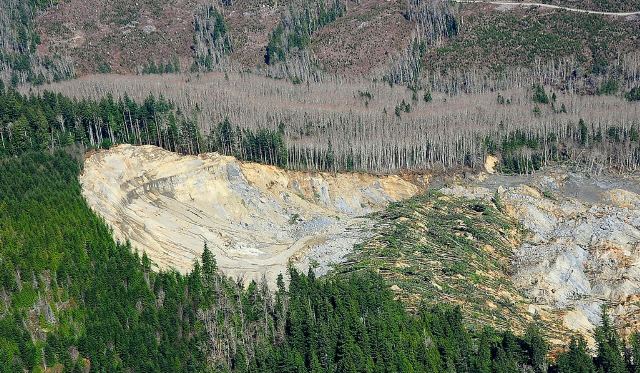 Here at Atlas World Headquarters we’re learning as much as we can about the circumstances leading up to the tragic Oso mudslide. Disasters like that are newsworthy in the US precisely because they are infrequent. We learned hard lessons about floods and fires in the early stages of settling the continent, before our population was so large and had decided to live so deeply in the wilderness. From those experiences, and with engineering input, we created regulations that, most of the time, protect most of the population from natural disasters.
Here at Atlas World Headquarters we’re learning as much as we can about the circumstances leading up to the tragic Oso mudslide. Disasters like that are newsworthy in the US precisely because they are infrequent. We learned hard lessons about floods and fires in the early stages of settling the continent, before our population was so large and had decided to live so deeply in the wilderness. From those experiences, and with engineering input, we created regulations that, most of the time, protect most of the population from natural disasters.
The main problem with this American, reactive approach to safety regulations is that useful safety improvements almost always are adopted after a major disaster, when death and destruction has already visited a community. Seismic design provisions in the building code were finally considered after the 1906 San Francisco event, but weren’t adopted in California until 1933. Double-hulled oil tankers after Exxon Valdez, inspect and repair your levees after Katrina, the pattern is obvious and tragic. In each case there are qualified experts, rational men of science, well aware that tragedy is only a matter of time but who are not taken seriously by the people’s representatives until the “likelihood” of disaster turns into a horrible certainty.
The Oso landslide follows this typical pattern. The hill across the river is called Landslide Hill, for Pete’s sake. This landslide has expanded in six documented episodes since 1949 and almost certainly predates development in the area. Reasonable people could disagree whether the data foretold an event like the one that occurred, a 2-stage rotational failure that forced a mudflow across the river to bury the neighborhood. The hazard was known but not with the certainty that could force land use changes that would have saved lives. Snohomish County approved building permits at houses that were plainly in harm’s way and are now under the mud, and the Washington DNR has permitted logging above the slide with only nominal and, likely, ineffective restrictions.
My consulting practice is showing signs that this will change. Sophisticated landowners are now considering the long-term benefits of incident avoidance as a method of slowing regulatory expansion. The political process is not orderly at the best of times and is particularly unpredictable in the face of disaster, when the non-technical electorate is demanding that “someone do something.” Hastily adopted, reactive regulations often overshoot the mark. Since the new regulations cover the entire industry, the entire state, the entire business operation, the cost of compliance usually far exceeds the cost of self-imposed operational improvements that might have avoided the incident and prevented the regulatory expansion.
At Oso, the landowner is a small forest resources company with very low profile, not the group you would expect to lead the industry in operational improvements. They cut timber because the regulations permitted it and they are in the business of cutting timber where permitted. The larger forest products companies in Washington, though, have adopted practices that may have prevented logging above a place called Landslide Hill. Their practices are unlikely, now, to be considered as Washington adopts new logging regulations.
Atlas works in a number of industries with such systemic regulated risk. Liquid and gas pipelines, rockfall, power plants, high-profile infrastructure with significant risk. We evaluate the whole cost of incidents, including natural hazard risk, as it affects our client’s reputation and their operational flexibility. An incident on your line, or even in your industry, has huge implications on new permit applications. The two main Canadian liquid petroleum pipeline operators are managing exactly this risk as they apply for major permits to move crude to market from Alberta. Those pipelines can be built and operated safely, and it would be nothing but bad luck if a small operator with a shoddy record had a preventable incident that, in the view of the non-technical electorate, gave the entire pipeline industry a black eye.
There are other aspects of the Oso disaster that bear further analysis, and we’ll organize our thoughts in a future post. For now, we hope that the responders stay safe through the difficult, muddy clean up, that the community recovers and the road re-opens, and that the forest products industry maintains its voice in the unavoidable evolution of Washington’s logging rules.
For those of you with more interest, the AGU Landslide Blog has excellent technical coverage of this event.
http://blogs.agu.org/landslideblog/
The first hint of logging regulation changes that are, now, almost inevitable in Washington is here:
http://slog.thestranger.com/slog/archives/2014/03/27/is-there-a-connection-between-the-mudslide-and-our-states-historical-mishmash-of-logging-regulations
And those of you interested in model regulations would do well to be aware of Oregon’s excellent Forest Practices Act, which can be accessed here:
http://www.oregon.gov/odf/PUBS/docs/Forest_Facts/FF-LandslidesDebris%20Flows2013.pdf
